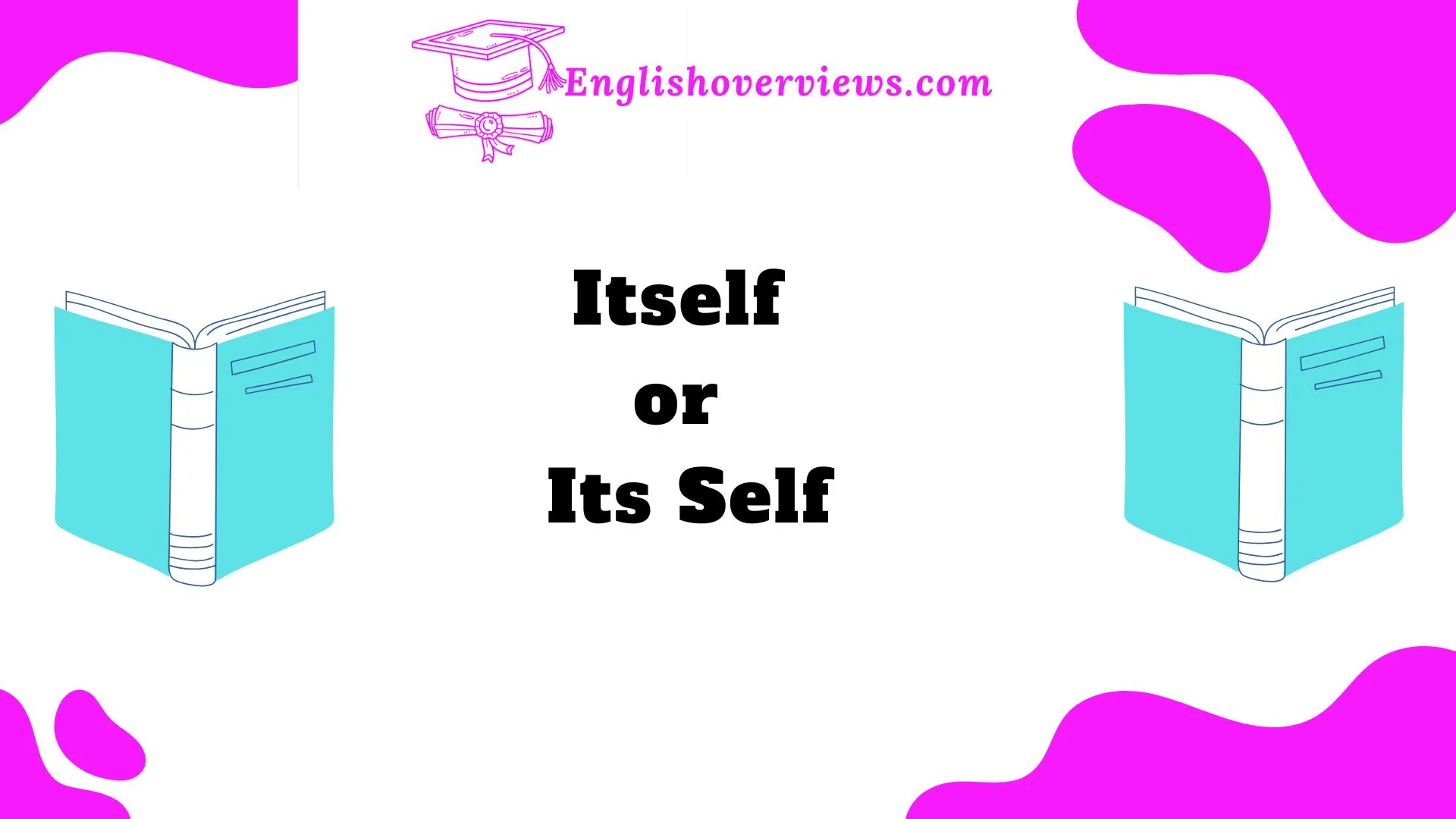English can be a tricky language, especially when it comes to words that seem to be so similar, yet carry different meanings. A perfect example is the confusion between “itself” and “its self.” You might have seen these terms used interchangeably, but they are not the same. Understanding the difference is crucial for proper grammar and clear communication.
In this blog post, we’ll dive deep into the correct usage of these two terms, explore their roles in English grammar, and provide practical examples to help you avoid common mistakes. Whether you’re a writer, student, or language enthusiast, grasping the nuances of reflexive pronouns and possessive forms will elevate your understanding of English grammar.
By the end of this article, you’ll know the exact contexts where “itself” and “its self” should be used. So let’s get started and clear up the confusion once and for all!
What is a Reflexive Pronoun? A Foundation for Understanding ‘Itself’
Before we dive into the differences between “itself” and “its self,” it’s important to understand what a reflexive pronoun is and how it functions. Reflexive pronouns are words like myself, yourself, himself, herself, itself, ourselves, and themselves. These pronouns are used when the subject and the object of the sentence are the same.
Definition and Role of Reflexive Pronouns
A reflexive pronoun reflects back to the subject of the sentence. For example, in the sentence “The dog washed itself,” the subject (the dog) is performing the action on itself (the object).
Here’s a quick list of common reflexive pronouns:
- I → myself
- You → yourself/yourselves
- He/She → himself/herself
- It → itself
- We → ourselves
- They → themselves
When you use “itself,” you’re referring to an object or animal that does something to itself. This usage is clear and grammatically correct.
Why ‘Itself’ Works in Sentences
When using “itself,” you’re telling your reader that the subject is acting upon itself. For example:
- “The machine fixed itself.” (The machine performed the action on itself.)
- “The company is proud of itself.” (The company is proud of its own actions.)
These examples show how “itself” is used in reflexive sentences.
The Contextual Use of ‘Itself’: Clear, Straightforward, and Effective
Let’s now explore how “itself” works in a practical context. When we use “itself” as a reflexive pronoun, it is usually clear and easy to spot. The sentence is typically about something performing an action on itself. This is an essential aspect to remember when determining when to use “itself”.
Practical Examples of ‘Itself’
Consider these examples to better understand how “itself” is used:
- “The clock struck midnight all by itself.”
In this sentence, “itself” refers to the clock performing the action on its own. No external force made the clock strike. - “The cat cleaned itself after the mess.”
Here, “itself” is used to indicate that the cat performed the cleaning action on its own body. - “The problem solved itself.”
In this case, “itself” is used to show that the problem resolved without intervention.
These sentences are clear, straightforward, and show how “itself” is used when the subject is acting on itself.
What About ‘Its Self’? When and Why It’s Not a Common Choice
Now, let’s talk about “its self”—and why it’s not commonly used. At first glance, it may seem like “its self” is just another variation of “itself,” but it’s not.
Why ‘Its Self’ Is Rarely Used
In most cases, “its self” is considered incorrect in everyday English. The term “its” is a possessive pronoun, and in these cases, we do not need an apostrophe. “Its self” is often seen in philosophical or religious texts, but it’s not a standard usage.
For instance, you may see the phrase “The self of the entity” in religious or philosophical writing, but even then, “its self” is often replaced by “itself.”
Philosophical and Religious Use of ‘Its Self’
Although “its self” doesn’t typically appear in everyday language, you may still encounter it in very specific contexts like philosophy or religion. An example might be:
- “The soul seeks its self.”
Here, “its self” refers to a concept in which “self” is used in a more abstract sense, not as a reflexive pronoun.
This usage is rare, and for most grammatical purposes, “itself” is preferred.
Common Pitfalls: ‘It’s’ vs. ‘Its’ – Clearing Up the Confusion
One of the most common mistakes in English grammar is mixing up “its” and “it’s.” These two words sound the same but have completely different meanings.
Difference Between ‘It’s’ and ‘Its’
- “It’s” is a contraction for “it is” or “it has.”
- “Its” is a possessive pronoun, meaning something that belongs to it.
When to Use ‘It’s’ and ‘Its’
Here are some examples to help distinguish between “it’s” and “its”:
- “It’s raining outside.” (Contraction for “it is”)
- “The dog chased its tail.” (Possessive form, indicating that the tail belongs to the dog)
Common Mistakes to Avoid
- Incorrect: “The cat played with it’s toy.”
- Correct: “The cat played with its toy.”
Remember, “it’s” can only be used as a contraction, never as a possessive.
Understanding Possessive Pronouns: Dropping the Apostrophe in ‘Its’
You may wonder why “its” does not require an apostrophe, unlike “John’s” or “the dog’s.” The possessive form of “it” is “its” without an apostrophe.
Possessive Pronouns: ‘Its’ vs. Other Forms
Here’s a helpful comparison between possessive pronouns with and without apostrophes:
| Possessive Pronoun | With Apostrophe (Incorrect) | Without Apostrophe (Correct) |
| It | It’s | Its |
| John | John’s | Johns |
| The dog | The dog’s | The dog’s |
Why No Apostrophe in ‘Its’
“Its” shows ownership or possession. So, when you refer to something as belonging to “it,” you write “its” without an apostrophe. For example:
- “The company took its customers seriously.”
When ‘It’s’ Is Not ‘Its’: Practical Examples to Strengthen Your Grammar
Understanding the difference between “it’s” and “its” will improve your writing. Let’s dive into real-life examples to make it even clearer.
Real-Life Examples of ‘It’s’ and ‘Its’
- Correct: “The car broke down, and it’s being repaired.” (Here, “it’s” means “it is.”)
- Incorrect: “The car broke down, and its being repaired.” (This is wrong because “its” is a possessive pronoun, not a contraction.)
Remember, “it’s” = “it is” or “it has,” while “its” shows ownership or possession.
Common Mistakes in Writing and Speech
- Incorrect: “The cat went to its bed because it’s tired.”
- Correct: “The cat went to its bed because it’s tired.”
Conclusion: Mastering the Nuances of ‘Itself’ and ‘Its Self’
To wrap it up, understanding the difference between “itself” and “its self” is essential for clear and effective communication. The term “itself” is a reflexive pronoun that reflects back to the subject of the sentence, while “its self” is rarely used and often considered incorrect.
Key Takeaways:
- Use “itself” when you need a reflexive pronoun.
- “Its” is a possessive pronoun, no apostrophe is needed.
- “It’s” is a contraction for “it is” or “it has.”
- Avoid using “its self” unless in a very specific philosophical or religious context.
FAQs
- Can I use “its self” in regular conversation?
- No, “its self” is not commonly used in everyday English. It is only seen in specific, more abstract contexts like philosophy.
- When should I use “it’s” instead of “its”?
- Use “it’s” as a contraction for “it is” or “it has”. For possession, always use “its” without the apostrophe.
- What is a reflexive pronoun?
- A reflexive pronoun refers back to the subject of the sentence, like “itself” in “The dog cleaned itself.”
- How can I remember when to use “its” vs. “it’s”?
- Remember: “its” is for possession (like “its tail”) and “it’s” is short for “it is” or “it has”.

Alyan Ashraf is the creative mind behind English Overviews, a platform dedicated to helping learners master the English language. Passionate about education and language development, Alyan specializes in simplifying complex English concepts, making learning accessible for students of all levels.











